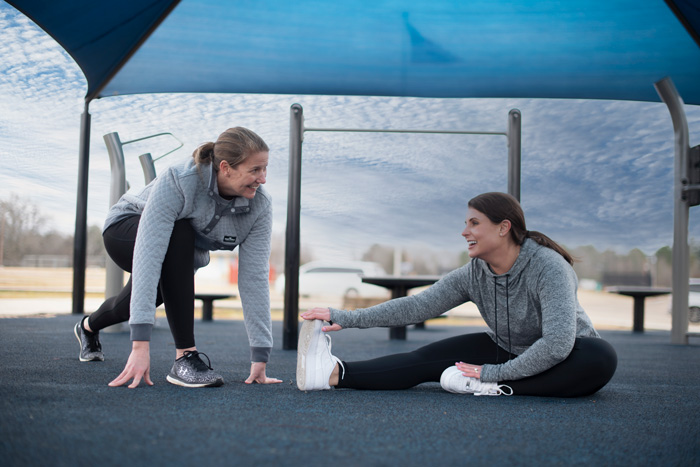Developers and manufacturers of modern fitness equipment, in concert with trail and park designers, have taken the essential elements of indoor exercising outdoors, a trend that has surged since the COVID-19 pandemic, providing community members of all ages and abilities with diverse options to stay physically active. This news is particularly welcome for those who may not have the financial means to join a gym. Outdoor fitness has come a long way from the simple exercise trails of the past. Nowadays, exercisers of all ages and abilities can get a full cardio or strength workout outdoors.
“In the early 1980s,” said Kent Callison, marketing director for a playground equipment company based in Chattanooga, Tenn., “we pioneered the outdoor fitness experience with very simple-looking equipment such as push-up bars, chin-up bars that you placed along a walking path intended to get adults exercising outside. From there we started adapting new and different ways for adults to exercise. There was an evolution of the park course design, adding things like chest presses, recumbent cycles, hard-heel walkers (the user stands on two platforms and moves back and forth).
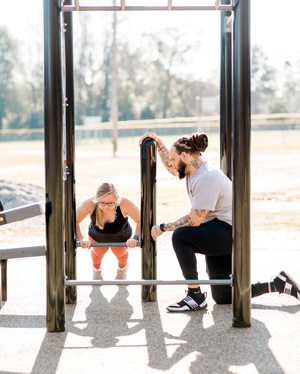
Callison recalled his company getting calls from CrossFit gyms saying they wanted something more extreme outside, more challenging. “We started talking with exercise physiologists, physicians and trainers and elite athletes, asking what outdoor fitness should be. Over the last 30 to 40 years, we created a whole new generation of outdoor fitness products that could fit in a very small space, that you could spread out along a trail, that can complement a playground, be adjacent to it in its own area so that adults can see their kids and kids can see their parents. The whole idea being we wanted to create outdoor recreation that promotes active healthy lifestyles for every age group. Equally important, … including options for persons with disabilities.”
Think back to the 1980s and the early days of outdoor fitness, said Randy Watermiller, vice president, product development for a Delano, Minn.-based equipment company. “Our offerings consisted of individual pieces of equipment that users could engage with as they walked or ran along a trail, promoting intermittent exercise. Today’s fitness equipment, however, is about creating a comprehensive fitness environment within a single, well-designed space.”
“Our sedentary lifestyle today meant that many people who would encounter these structures along trails and in parks couldn’t do most of the exercises,” added Allison Abel, marketing director for a California-based outdoor fitness equipment manufacturer. “To make outdoor fitness something that benefits a larger portion of the population, new and innovative designs had to be developed.”
That is exactly what happened. Equipment manufacturers responded to the challenge in myriad ways. One was via the concept of body-weight leverage resistance, in which machines such as chest presses are constructed so the users are working against a portion of their body weight.
Another relatively recent concept, Abel said, “is the use of pistons to provide resistance. The benefit of this type of equipment lies in the adjustability of the piston, allowing the resistance level to be tailored to the needs of each individual, thereby giving the apparatuses the ability to serve a wide range of users.” Sometimes, when there are no kids around at a playground, adults will make use of certain playground elements, such as platforms and overhanging bars and use them for working out.
However, Abel explained, “functional fitness equipment is now available that features these types of elements and much more, designed specifically to give tremendous options to adults looking for a challenging workout. These elements enable park visitors to enjoy many of the same activities they would in a private indoor gym—but in the open-air environment and at no cost to them whatsoever.”
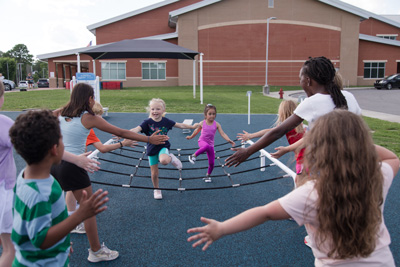 The development of mechanisms that allow variable adjustment of resistance has been a game-changer, Watermiller said. “This innovation enables users to customize their workouts according to their fitness levels, providing a gym-quality experience in an outdoor setting. Our equipment is designed with long-term durability in mind, ensuring it can withstand various weather conditions and continuous use, making it ideal for outdoor environments. We’ve developed pieces that mimic the experience of indoor gyms and made it accessible to everyone.”
The development of mechanisms that allow variable adjustment of resistance has been a game-changer, Watermiller said. “This innovation enables users to customize their workouts according to their fitness levels, providing a gym-quality experience in an outdoor setting. Our equipment is designed with long-term durability in mind, ensuring it can withstand various weather conditions and continuous use, making it ideal for outdoor environments. We’ve developed pieces that mimic the experience of indoor gyms and made it accessible to everyone.”
As trends shifted toward more dynamic forms of exercise, and Ninja fitness grew more popular, equipment manufacturers recognized the need to go beyond traditional gym equipment to create more extreme equipment that provides an obstacle course-like experience that is both fun and challenging, appealing to those who seek an engaging alternative to conventional gym workouts.
“We have collaborated with medical experts to advance our understanding of how to design outdoor fitness equipment that keeps adults safe and injury-free. This helps ensure that our products meet industry safety standards while also offering safe, reliable and effective fitness solutions for communities,” Watermiller said.
Research and new technologies have paved the way in the development of new and better equipment, agreed Sarah Lisiecki, communications and education manager, at a Fond du Lac-based equipment company. “More and more research tells us how important movement is, yet more and more technologies make it easier for us to be sedentary. Finding ways to encourage people to be active outdoors and keep them motivated is part of how we’ve been able to use research to create outdoor fitness equipment and spaces.
“Achievement motivation theory is one way obstacle course fitness keeps people motivated,” Lisiecki continued. “By definition, it is the effort an athlete makes to succeed within their chosen field. It helps them overcome obstacles or master a particular task, and obstacle courses are perfect ways to tap into these motivations. This type of science research and product development allows us to offer products and designs that help motivate people to reach their goals.”
Benefits to Communities
Another trend in outdoor fitness has been finding ways to get more people into a smaller space because free space has become more of a premium, particularly in urban areas, said Callison. “We developed a compact design, where as many as 20 people can exercise in as little as 250 square feet. This has been great on college campuses and in parks. Middle schools and high schools have adopted it for team training and fitness training.”
As the mental health and well-being of college students has grown into a bigger issue for campus recreation directors and university presidents, Callison said, “they are finding the retention of college students is harder than ever because of emotional wellness—young adults who are depressed and struggle with anxiety. That is mitigated tremendously when they are engaged in outdoor exercises. So, bringing these compact outdoor exercise areas gives them a place to exercise, socialize.”
Active students perform better in school, have better test scores and are a better behaving class, Callison said. “When you provide outdoor fitness spaces for older adults, they have less incidents of depression; they are not stuck indoors. It might be the single greatest thing we can do for communities and society at large is create more space where people can be active and active together.”
Agreeing with Callison is Mimi Marler, Director of Marketing for a Chattanooga, Tenn.-based play, recreation and fitness equipment company. “Physical exercise significantly contributes to overall health, both physically and emotionally. Exercising outdoors allows individuals to work out freely at their own pace. Municipal parks are now appealing to all demographics."
Lisiecki added, “Creating outdoor spaces for everyone to move in is critical for the overall health of individuals and communities. Children ages 12 to 19 have the highest obesity rates of all children, have mostly ‘aged out’ of traditional playground equipment and need to be engaged in movement and stay motivated.”
“It’s a tall order to reach all age groups,” Marler said. “Add in adults, and the reasons many adults don’t exercise—lack of time, facilities, childcare, fear of the unknown—outdoor exercise equipment must be challenging, yet inviting, fun, yet impactful, and be in places where children and adults can gather and move at their level in a place that is designed for them.”
Well-designed outdoor fitness spaces provide a variety of benefits to entire communities. Exercising outdoors brings not only the benefits of exercise, which are numerous, but also provides benefits from just being outside. Designing equipment to help people meet their fitness goals while having fun is key to creating habits that last. Studies show when people have increased enjoyment and challenge in their workouts, they work out more and return to the space.
It helps to create an inviting space, Watermiller suggested. “To further enhance the appeal and usability of outdoor fitness equipment, we also consider practical aspects such as the inclusion of shade. Providing shade over and around outdoor fitness equipment protects users from the elements, making it possible to work out comfortably in different conditions.”
Promoting Active Lifestyles
Playground equipment has always been intended to keep kids active. And studies show that the easiest way to prevent childhood obesity is through exercise. If you can help adults be healthier, then their children will be healthier by extension.
“As a company, we started thinking about that,” Callison said. “Playground equipment was keeping kids active, but how can we keep people active once they reach adulthood. By the time a kid is 12 or 13 they have outgrown the traditional playground. Then, unless they are involved in team sports there are many things that steal their attention and can lead to a more sedentary lifestyle.
“We found from studies by the Mayo Clinic and AARP that the number-one cause of emergency visits by older adults is falls. And those falls are a result of poor balance and coordination. We created equipment to improve balance and coordination, equipment with assisted handles and lower step heights, flexibility and balance exercises specifically designed for older adults. We are into this from 6 months of age to as long as you live,” Callison said.
Inclusivity and accessibility in outdoor fitness equipment are essential for serving all demographics, Marler said. “It’s important to create opportunities for every walk of life and every physical ability level to exercise and enjoy the outdoors.”
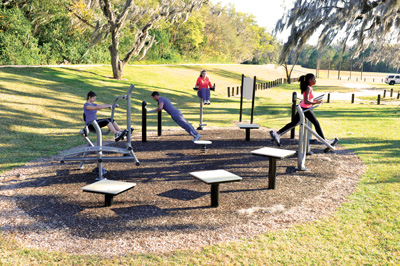
“We design our equipment to be inclusive and adaptable,” agreed Watermiller. “Modern outdoor fitness equipment is designed to serve a diverse group of age ranges and abilities. We recognize the importance of catering to diverse age groups and fitness needs. This approach encourages families and individuals to stay active and fit together.”
By focusing on ages 13 and up, Watermiller continued, “we are addressing a previously underserved age group. Middle schools are increasingly incorporating our extreme fitness equipment to keep kids in this age range active, engaged and challenged physically. This helps bridge the gap for adolescents, offering them a dedicated space to play, exercise and develop healthy habits. Schools are also leveraging the equipment to enhance their physical education programs, incorporating it into their curriculum to promote fitness and wellness among students.”
A commitment to inclusive outdoor exercise areas is reflected in the diverse range of available equipment. “Whether it’s for a municipal park or a school district, the goal is to create environments where everyone can improve their mood, energy levels and endurance simply by being outdoors,” Marler noted. “The importance of health and wellness in our communities is paramount, and providing the necessary tools to support this mission is essential.”
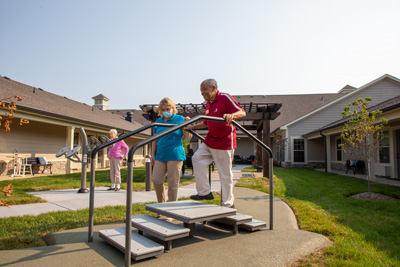 “We want our equipment to be usable by as many people as possible, and our primary source of info for refining our product lines are the end users,” Abel explained. “Our company has zeroed in on the accessibility angle. There really aren’t a lot of accessible amenities in open spaces that encourage those with disabilities to enjoy physical activity. To that end, we’ve worked with our accessibility adviser, a former Paralympian, to refine the design of our fitness equipment for those with mobility impairments. We’re also working on some new units that came about as a response to feedback from the head of the Spinal Cord Injury Department of the VA, which we’re excited to debut soon.”
“We want our equipment to be usable by as many people as possible, and our primary source of info for refining our product lines are the end users,” Abel explained. “Our company has zeroed in on the accessibility angle. There really aren’t a lot of accessible amenities in open spaces that encourage those with disabilities to enjoy physical activity. To that end, we’ve worked with our accessibility adviser, a former Paralympian, to refine the design of our fitness equipment for those with mobility impairments. We’re also working on some new units that came about as a response to feedback from the head of the Spinal Cord Injury Department of the VA, which we’re excited to debut soon.”
This type of equipment can be a real boon for parks in economically depressed areas, Callison said. “There are many reasons for that. One is that people who live in economically depressed areas are not going to Europe or the beach for a vacation. A park is their vacation, so finding ways to make sure we follow the social path that is created by these outdoor fitness spaces is phenomenal.”
Outdoor fitness areas in any kind of park can provide ways for community members to connect with one another, too. “We see people who might ordinarily never meet or know each other work out together,” Callison said. “Removing barriers to health and wellness is important. Parks are perfect for that. If you put an outdoor fitness space in a park, you have created a free gym. People can be outdoors with their friends, make new friends and socialize. Tension sometimes disappears when you are in a workout space or exercising with friends. That’s where you don’t see people talking about their differences but about things that have brought them together. That is huge.”
A Well-Rounded Workout
Today’s outdoor fitness equipment for adults is typically designed for ages 13 and up, Marler said, “and it is important to partner with a manufacturer who designs these based on a well-rounded fitness program that addresses five key areas: aerobic fitness, muscle strength, core strength, flexibility and balance. This equipment is suitable for adults of all fitness levels, with universal designs accommodating those in mobility devices, and several pieces focusing on rehabilitation and balance for the active aging population. The equipment is versatile enough to cater to both beginners and seasoned athletes, offering various modification options for a great workout.”
For adults, Watermiller explained, “we have exercise equipment that focus on strength training, cardiovascular fitness, and stretching and balance—apparatus that offers something for highly trained users as well as aging users to aid in maintaining mobility and independence. This equipment is designed to welcome the entire community to engage in physical activity that is both effective and safe.”
Designing a fitness area with diverse equipment means working with a supplier who can identify and provide solutions for each of these key fitness areas. “Our approach,” Watermiller said, “is to ensure that each piece of equipment not only fits within these categories but also clearly communicates its purpose to the user. This means that users can easily identify what they will be working on, whether it’s endurance, strength, flexibility or balance. We offer equipment with variable resistance that can be adjusted to meet the user’s fitness level and goals. This allows for effective aerobic and strength training workouts that enables users to progressively increase their workout intensity and build muscle strength safely. Flexibility, stretching and balance are equally important components of a comprehensive fitness routine.” RM
All photos courtesy of ActionFit by UltraSite
For more information:
ActionFit by UltraSite
www.actionfitoutdoors.com


